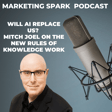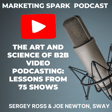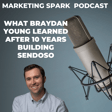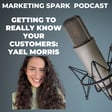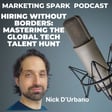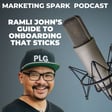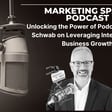Become a Creator today!Start creating today - Share your story with the world!
Start for free
00:00:00
00:00:01

The New Age of Marketing-Driven Sales: Shiv Narayanan
At a time when conferences are not happening and salespeople can't meet with prospects, marketing has become a key revenue engine.
A growing number of B2B and SaaS leaders are realizing that marketing can effectively attract, engage, and nurture prospects.
Marketing is no longer supporting sales but driving sales.
And, in the process, marketing is getting more respects and budget.
In this episode of Marketing Spark, Shiv Narayanan gets into the different roles that marketing is playing.
We explore the growing importance of content marketing and how CMOs and CFOs need to establish close working relationships.
Transcript
Introduction to Marketing Spark Podcast
00:00:00
Speaker
You're listening to Marketing Spark, the podcast that delivers insight, tools, and tips from marketers and entrepreneurs in the trenches in 20 minutes or less.
Evolution of B2B and SaaS Marketing
00:00:09
Speaker
It's been, well, an interesting year for B2B and SaaS marketing and marketers. Conferences have disappeared. Content marketing, brand positioning, and branding are back at big time. In many respects, marketers have been forced to reload, rethink, and refocus to connect and engage with prospects and customers.
Featuring Shiv Narayanan on Marketing Strategies
00:00:29
Speaker
To provide some perspective and hopefully guidance on what's ahead, I reached out to Shiv Narayanan, CEO of Hatasas, a management consulting firm that works with private equity firms and their portfolio companies to help them scale their marketing and growth. Welcome to Marketing Spark. Hey, Mark. Thanks for having me.
00:00:47
Speaker
So one of the things that we were talking about before this interview was how busy you are and unfortunately how busy
Is This Year Pivotal for Marketing?
00:00:54
Speaker
I am. You said something that resonated and you said, this is the year for marketing. What did you mean by that? Yeah, so I think what's interesting is historically companies have been built on sales, right? So, and when I say built on sales, most organizations, if you think about how they start, they usually start with a subject matter expert
00:01:16
Speaker
who has some inroads they have what's called an urn thesis they've learned something about a market or pain point that people have and then they build some level of expertise and then they see a problem and they decide to start a company to solve that pain point or problem and then they end up becoming the first sales reps of the organization.
00:01:35
Speaker
And so as time goes on, the way the organization grows is by the founder leading
Transition from Founder-Led Sales to Marketing-Driven Revenue
00:01:40
Speaker
sales. It's called founder led sales. And then as time continues to progress, the founder starts to replace themselves and hire people to grow the organization. And the first roles that they replace are sales roles.
00:01:52
Speaker
And so that's why you know a founder's first hire might be an sdr and they continue to be the ae as time goes on and the higher an account executive and pull themselves out of that and then become like the sales lead and so they'll be managing three to four sales reps and before you know it you've grown past ten twenty thirty even hundred million in revenue and you have a massive sales organization of fifty two hundred people.
00:02:14
Speaker
And in that time marketing is kind of looked at as a supporting cast member. Marketing's primary role inside of a lot of these sales organizations is to do everything it needs to do to support the sales motion and give sales a supported need. So that could be in the form of sales enablement content.
00:02:30
Speaker
in terms of creating decks or one pagers or battle cards and things like that. It could be in the form of product marketing to educate existing customers and drive some upsells through content that the sales team can then close. And it could be event marketing, where you're going to these trade shows and helping salespeople build relationships by getting a booth and having your CEO or somebody speak on the stage and then collecting badge scans as people walk by your booth. And then if you look at a year like this, you have
00:02:59
Speaker
no more conferences. And sales has far fewer venues to build relationships outside of the digital realm. And meanwhile, marketing is still in that supporting cast member role.
How is Marketing Becoming a Revenue Driver?
00:03:12
Speaker
And then you have CEOs and boards wondering, well, my pipeline is slowing down. How am I supposed to ramp up pipeline in a marketplace where people can't meet each other and sales was the only rainmaker inside my organization? So I think that's the big shift.
00:03:25
Speaker
It's a long-winded way of getting there, but this big shift is marketing needs to be a revenue driver. CEOs recognize this, investors recognize this, and marketers have been trying to beat that drum for a long time, but they just haven't been taken seriously enough inside of an organization, and a big part of that is marketing's fault, and we can dive deeper into that. But now that people that have power and authority over budget buying into that,
00:03:52
Speaker
more investment is going into marketing this year than ever before. And so that's why it's a great time to be a marketer.
Adapting to the Loss of Conferences
00:03:58
Speaker
I've been thinking a lot about conferences. In fact, the disappearance of conferences, because the companies that I've worked for and worked with have allocated B2B companies allocate a lot of money to conferences. The last company I was at, they probably spent 75% of their marketing budget going to attending, sponsoring, speaking at conferences. But when conferences disappeared, a lot of marketers lost their go to channel.
00:04:22
Speaker
The ability to engage and connect and meet with prospects suddenly disappeared. And I think my thinking is that a lot left a lot of marketing marketers and organizations exposed. The other marketing that they were doing maybe wasn't that effective or they weren't doing enough
00:04:40
Speaker
of it do you think that that is sort of the lay the land these days is that without conferences without that ability to easily connect with prospects and customers that that organizations now realize that there's other types of marketing that need to happen and then and that in turn has raised the profile and value of marketing. Well, I think a big contribution to the.
00:05:01
Speaker
to the problem being described is generated by marketing. If you really dig under the hood of B2B companies and you look at these conferences that they're going to, you begin to notice some patterns around where marketing spend is going, especially those trade shows that you alluded to. And in most of those organizations, sales is, excuse me, marketing is going to these conferences and 80% of those conferences are not delivering any
Rethinking Trade Show Investments
00:05:30
Speaker
revenue
00:05:30
Speaker
or barely any revenue at all and meanwhile marketing gets to an all hands meeting and talks about the three hundred badges a scan at a particular conference right and so it loses a lot of credibility as it starts to do things like that in front of the sales team and so if twenty let's say fifteen twenty percent of sales of trade shows inside most companies drive eighty to ninety percent of the actual pipeline,
00:05:54
Speaker
that comes from that channel that means eighty percent of your trade show spend is actually being wasted and not only your trade show spend but the time you spend to organize that thing that the people you had to fly down the dinners that the meetings that you have with potential clients that all this money is going into this specific channel meanwhile.
00:06:15
Speaker
different channels that can generate pipeline just as effectively, if not better, things like content marketing, SEO, something as simple as Google ads or paid social ads or organic content on social, all of these things are completely ignored. And so I think
00:06:32
Speaker
When you it's almost like you purposely become you lose you lose an arm right and you're like what do i do and so you kind of have to use your left hand and that's kind of where you're looking at all the other marketing tools in your toolbox and finally people are starting to notice that hey.
00:06:49
Speaker
Content marketing can be a big lever for us. We're not out there producing enough thought leadership content. We're not producing enough webinars or video or leveraging content for our sales conversations. Our sales team only sends out messages to book demos. They don't send any pieces of thought leadership to prospects who they're engaging with and those prospects have the same problems that
00:07:10
Speaker
we would encounter at a trade show but we speak at that trade show and we have brochures and we're actually handing out content that probably generates that pipeline. But on the content side or sales enablement side or SEO or paid social or all these other channels, we're not putting the same amount of effort and we're giving the marketing team a small marketing budget in order to be able to generate the pipeline that they're ultimately accountable for.
Will Companies Return to Conferences?
00:07:33
Speaker
Yeah, for lack of a better analogy, conferences have been the drug that many marketers have been addicted to for a long time. Conferences are easy. They're high profile. If you can get your senior executives on stage, they feel good. You can pay to win an award, and then those logos can go on your website. It's an easy game to play.
00:07:52
Speaker
what I'm wondering about is going forward. Now the companies haven't been able to go to conferences and they've been, they've been forced to explore different channels and opportunities. What does that say about the future of conferences? Do you think that a lot of B2B and SaaS companies will snap back to their old habits or do you think they'll be more selective? Maybe they'll go to fewer conferences. Maybe they'll maybe evolve into virtual events. What's your take of what could happen nine months to a year from now?
00:08:20
Speaker
You have to be more selective. In fact, people should have been selective before they were forced to not go to these conferences in the first place. That's not to say all conferences aren't worth doing, because in every industry, there might be two or three landmark events that a company has to be a part of, and that makes sense. But in most cases, you do not need to go to most trade shows. And on the flip side, the question is, what
00:08:44
Speaker
Where else could that budget be going? That's a question that this opportunity cost question that has been omitted for more than a decade now as B2B has been building into this massive category of companies is where else can you deploy five, six, seven, $800,000 of your budget that you're investing into these trade shows that aren't really that good a driving pipeline in the first place,
00:09:07
Speaker
Where else can that go and how much value is being lost if you're not investing into those channels? Like that's one of the biggest questions we've been asked by investors and CEOs this year is like we had, we were investing, you know, 1.2 million in trade shows. Now we have that marketing budget.
00:09:22
Speaker
at our disposal, what can we do with it on LinkedIn? What can we do with it on Facebook? What can we do with it in terms of content? And that's one of the questions we've been answering for them, that previously they never stopped to ask themselves and they gave up that opportunity cost to other companies who did notice that. And if you look at every software category or B2B category, there are usually one or two, three 800 pound gorillas in the room that have
00:09:51
Speaker
dominated that market, not just because they're going to the conference, but they're also investing just as heavily in these other channels and being present across all of them with the right content, with the right offer, with the right nurturing path and the right strategy and the right message to be able to get those people to convert. Right. So now, now's the time better than ever to just refocus and restart and rethink how you're going to allocate your budget more effectively to capture that opportunity cost.
Filling the Void with Content Marketing
00:10:19
Speaker
I agree. I think that was one of the most interesting things that happened in March, April, and May when conferences evaporated. A lot of markers didn't know what to do and what I saw was a lot of panic because this tool that they had been using, this channel,
00:10:35
Speaker
was no longer available in their toolkit so they had to rethink and had to reload and some of them have reloaded quite successfully and others are still scrambling to figure out how they move marketing forward which is a nice segue into content marketing and you talk a lot about content on linkedin where you have a really great presence i'm trying to maybe get your thoughts on.
00:10:57
Speaker
What is the right approach that sass companies should take to content marketing notes a loaded question because it's all about education and thought leadership and really trying to engage prospects and customers what are the some of the fun to fundamentals that companies should be thinking about if they want to allocate some of those conference dollars to things like content marketing.
00:11:17
Speaker
Yeah, so we beat companies all the time that are in the process of getting a digital marketing motion going. And when they think about content marketing, they usually have one or two content writers on staff that start to produce these random blog posts as a form of thought leadership, right? So something that their audience might have some sort of a paint around, they'll write a 500 word post around that.
00:11:42
Speaker
And that's helpful. That's better than not putting out content at all. But one of the things that that means is about content marketing is truly understanding what are all the different roles that content marketing has to play inside an organization that is trying to scale its marketing efforts. So when you think about content, it plays so many different
00:12:06
Speaker
different roles for an organization. One, it helps you get customers discovered and helps them find your platform or solution. Number two, it helps nurture prospects and existing customers. Three, it enables the sales team. Four, it helps customers get onboarded onto the platform.
00:12:25
Speaker
Five it helps increase the usage of your product six it helps cross-sell and upsell other products to existing customers. Seven it helps you increase your prices and so that you have more expansion revenue from existing customers. It provides education to your customers to build loyalty and retention and advocacy.
00:12:42
Speaker
And nine, it positions your brand as a publisher and a thought leader in the space. So content has all these different roles to play. The problem is, inside most companies, you have one, two, maybe three content marketers who are responsible for doing all of this. So now, if I were to create a content roadmap, and product teams are really good at creating roadmaps because their entire function is about roadmaps. And content is very close as a function to product.
00:13:08
Speaker
but it doesn't operate like that. So if I look at all these priorities, they kind of conflict with each other because they all require resources. And so content has to look at all these priorities and say, what goes on my roadmap first because I don't have infinite resources. And I think that's the first path to success. And so based on that, then you say, where are the biggest opportunities? Because that's where I would like to focus my efforts.
00:13:32
Speaker
Inside most companies usually the answer is in finding people who are ready to buy or are in a buying window and getting them through to that closed one state whether it's an existing customer or whether it's a new customer. If it's a new customer do you have enough collateral out there to support buyers across their buyer journey if there are major gaps for example.
00:13:58
Speaker
If you're selling membership management software and you don't have a guide on membership management software for your prospects, well, that's a mistake. You better have that type of a guide because if you don't provide them with that guide, somebody else will. If you're selling e-commerce software and you don't have a place where people can look at
00:14:16
Speaker
online store software reviews like Shopify does and BigCommerce does and some of these other e-commerce platforms do, you're going to be left behind. So as you start to work down that roadmap, thought leadership content should almost come a lot later in your content roadmap. But that's kind of where people start, right? They go, I want to do the cool thing and I want to write fun articles that make people look at me as this big resource that they can rely on. The key is as you start to go
00:14:42
Speaker
work backwards from highest opportunity down to lowest opportunity and buyer journey people that are ready to buy back towards people who are almost unaware, over time you slowly build that whole engine out. And it's about doing it in the right order because once you start doing that and working down that priority list, over time you do emerge as a great content marketing organization because the unique thing about content is once you create an asset, it pays dividends forever. So if you do create that customer guide or pricing comparison page or
00:15:11
Speaker
a late funnel solution asset or a webinar podcast whatever that is it lives in perpetuity and it can be leverage in perpetuity for nurture stream or whatever else you're trying to use that content for where is other things like one off marketing programs. As soon as you finish the program you gotta start the next one and then once that one is finished start the next one.
00:15:31
Speaker
building those evergreen assets that can live and support your entire customer journey from when they are becoming aware of you all the way through to advocacy and everywhere in between. In my opinion, I mean, if you go about it in that order, you're going to have success. When you look at the SaaS and PDB landscape, are there companies that jump out that do content well, not just in terms of the type of content that's created, but how they play in different stages of the funnel and as important how they distribute content?
00:16:00
Speaker
Yeah, there are a bunch of companies that do a really good job here. FreshBooks comes to mind. Shopify comes to mind. Wild Apricot, the company I was seeing comes to mind. There are people that have figured out how to do content really well across all the different stages of the journey, right? And it's understanding all the pain points of your customers and truly trying to help them. I think that's the other thing.
00:16:25
Speaker
It's more of a subjective lens to think about it, is if you're just creating self-serving sales enablement content, that'll only get you so far. But true content is about helping resolve those pain points. Shopify is the gold standard. If you look at all the content Shopify creates, it's truly about helping entrepreneurs succeed. And then that finds its way through into
00:16:52
Speaker
content where they hold a build a business competition, which is more for PR purposes through to how to optimize your online store for SEO and which is a piece of content they might have, right? And it's very tactical and specifically helpful to an online store owner that's trying to figure out that specific problem. So I think looking at it from that type of a lens can go a long way, especially for B2B companies who aren't used to thinking about content and from the perspective of their client and what they need help with today.
00:17:21
Speaker
In a recent LinkedIn post, you talked about the alignment between the CMO and the CFO. And this is something that was very interesting to me. Cause I've talked a lot this year about alignment between the CMO and the CEO and why they need in many respects to be partners. Because if they don't see the world in the same way, they don't have the same priorities. They don't have the same vision moving forward. Marketing is not going to succeed. You're going to have two different perspectives, two different sets of priorities. If you're not synced.
00:17:51
Speaker
It's not gonna work. So maybe a little perspective on your thoughts about CEO, CMO, and then talk a little bit about that CFO, CMO alignment. Cause that's something I hadn't, hadn't thought about before.
Importance of Executive Alignment
00:18:03
Speaker
I think the key to really understand there is that all executives are aligned around two things I would say primarily. The first thing is vision and strategy, which is we have this vision for this business and we got to figure out the right strategy in order to get there.
00:18:23
Speaker
and you need to have alignment across not just the executive team but the entire organization in order to be on the same page to build the right product the right sales motion the right marketing materials the right customer success experience all of that stuff needs to kind of go. Hand in hand a good example is ikea there's a reason the furniture there is.
00:18:42
Speaker
super cheap, but at the same time they have self-assembly, right? So those two things go hand in hand and somebody at a higher level somewhere decided, we're going to have a self-serve furniture store where all the furniture is on hand and you have to self-transport it, also that the price is lower and it's more accessible worldwide, right? And I think IKEA consumes like 1% of the world's lumber as a result. So that's business strategy and the executive team needs to be aligned on that. The second part is resourcing.
00:19:09
Speaker
And resourcing comes from everything, from funding, to profitability, to assets on hand, to cash flow, all of these things are interconnected. And everything else flows from those two things. So if you think about sales, sales is a subset of business strategy. How you go to market is a subset of
00:19:32
Speaker
where or what the strategy is where you want to penetrate the market in the first place and marketing is no different than that right because it's the same question really we have this ideal set of customers this is the profile of the vertical persona industry use case whatever that our product or solution is a great fit for.
00:19:50
Speaker
And then the flip side of it, which I think for some reason, people seem to understand that sales and marketing obviously correspond to overall strategy. But the part that they miss is that the other side of this is there are limitations in every business in terms of how much cash you have on hand and what profitability targets you have and how much funding you have access to and how many people you can hire. These are financial decisions.
00:20:14
Speaker
And the more executives are connected to understanding the financial landscape of their specific organization, the more success they're likely to have because you're more likely to understand what you're dealing with, right? So if something as simple as your personal finances, well, you wouldn't go buy a $5 million house if you only have $20 in your bank account. Well, similarly, if you only have a marketing budget of $800,000, you wouldn't try to run a Super Bowl commercial.
00:20:41
Speaker
And so that alignment with the CFO, and I'm obviously using extreme examples here, but that alignment with the CFO becomes critical. The alignment with the CFO is the path to finding alignment with the CEO because the CEO is constantly having meetings with the CFO.
00:20:57
Speaker
or his or her investors to constantly say hey these were our targets here's how we're trending here's how much off where we are based on our projections here's how profitable we are we might need more funding we might need more investors i think you know we might run out of money here's our burn rate these are the conversations constantly happening between the ceo cfo and the investor
00:21:19
Speaker
And if you're not plugged into that conversation, if you're just plugged into the strategy, you're almost like trying to balance on one leg. You don't understand the other side of what is happening inside the organization.
CMO-CFO Collaboration for Budgeting
00:21:29
Speaker
So the more the CMO or the marketing leader is working with the CFO on the different financial statements, understanding what's on the balance sheet,
00:21:37
Speaker
understanding what's in the income statement and from a profitability standpoint, understanding what's happening with cash flow and how that impacts the funding realities of the company, the more likely that CMOs to succeed. And your CMO should really be your best friend if you're a CMO, right? Because that's the person that's telling you how much money you have to work with. And the more you can communicate to them, hey, you gave me $100,000 for this thing,
00:21:59
Speaker
And I brought us back 150K and here's the data to show you that. The more that person becomes your best ally in explaining that to the board, explaining it to the CEO and convincing them to give you even more budget. The path to marketing making more of an impact is whatever budget you have, show how it's impacting revenue. Use that to communicate it upwards to the CEO and the board.
00:22:23
Speaker
and based on that lobby for where you would deploy additional budget and what the potential ROI expectation from that can be and then repeat the cycle all over again and there's no way to do that without being truly connected with the CFO.
00:22:37
Speaker
One other question in terms of marketing budgets. What if you're an early stage company that doesn't have much of a budget?
Optimizing Marketing Budgets for Startups
00:22:44
Speaker
How do you determine where to spend limited resources? How do you figure out what your priorities are? And I guess how do you generate enough empirical evidence that you can go back to the CEO and say, okay, I want a little more money, not a lot, but a little more money. What is that overall approach when you're working with very limited resources?
00:23:03
Speaker
I think the answer is the same whether your marketing budget is $5,000 or $5 million is whatever budget you have that you have to work with, use that to run initiatives that are most likely to find you revenue first. And so if you have only $5,000 in budget to work with,
00:23:25
Speaker
Your best bet to deploy that budget is in a place where sales cycles will be shortened. You can validate the spend as quickly as possible and you can generate a return as you go through that full cycle and you can showcase the value to your board or your CFO or your CEO. Then you can ask for seven thousand, then nine thousand, then twelve thousand, then fifty thousand. You slowly scale that up and that it happens a lot faster than you would think because most boards actually there's not a board on this planet that will say no.
00:23:55
Speaker
to a channel or an area of an of investment that's not that's generating a return the more you communicate that the faster those loops can go in the marketing organization keeps getting more funding as a result the same thing happens with sales the only thing is because you started sales organizations you end up getting.
00:24:10
Speaker
More budget faster, but until one sales rep delivers, you don't have enough money to hire a second sales rep or a third one or fifth one. And so marketing used to think of it the exact same way. Five thousand dollars a month is pretty good budget to validate something with marketing, and that's enough to get you 10 and then 20. It's just doing the same process over and over and over again until that budget is making enough of an impact on the organization to have a much bigger seat at the table.
Creating Impactful Marketing Cartoons on LinkedIn
00:24:36
Speaker
Well, Shiv, this has been amazing insight. The question I would want to ask you and I think know the answer is if people want to know more about you, other than going to LinkedIn, where else should they go? Just check us out on our website, www.howtosas.com. We usually work with companies that are doing north of $5 million to upwards of $100 million. We work with several companies in the SaaS or B2B space, and we help them figure out their strategy for marketing and how much is the right budget for a specific business.
00:25:02
Speaker
One final question. You have developed quite a reputation for these little creative cartoons on LinkedIn. What's your secret? How do you do that? Is that something you do yourself or do you have some minions in the background that create it for you? No, I do them myself. Thank you for saying that. I think it was somebody who said that it takes a lot more effort to create something that's simple than something that's long-winded.
00:25:27
Speaker
And so that's what I try to do with those drawings is take really complicated marketing or strategy or growth concepts and boil them down to the one single diagram that is easy to consume, easy to understand, and hopefully can change the conversation. So I appreciate you saying that.
00:25:41
Speaker
If you're on LinkedIn and you haven't checked out Shiv's drawings, you should really do that. He really does say it quite accurately. It does take the complex and make it amazingly simple. Thanks for this Shiv. And thanks everyone for listening to another episode of Marketing Spark. If you enjoyed the conversation, leave a review and subscribe via iTunes or your favorite podcast app.
00:25:58
Speaker
If you like what you heard, please rate it. For show notes of today's conversation and information about Shiv, visit marketingspark.co slash blog. If you have questions, feedback, would like to suggest a guest or want to learn more about how I help companies, it's a fractional CMO, consultant and advisor, send an email to markmarketingspark.co. I'll talk to you next time.


